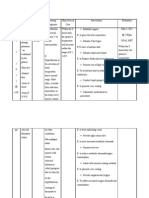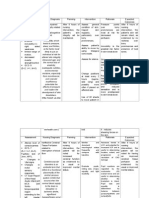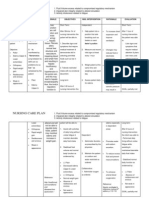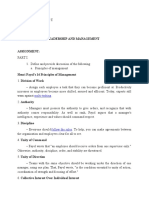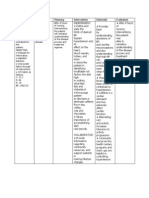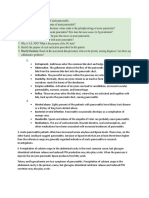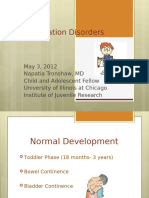Couretask Sample
Couretask Sample
Uploaded by
ej ragoCopyright:
Available Formats
Couretask Sample
Couretask Sample
Uploaded by
ej ragoOriginal Title
Copyright
Available Formats
Share this document
Did you find this document useful?
Is this content inappropriate?
Copyright:
Available Formats
Couretask Sample
Couretask Sample
Uploaded by
ej ragoCopyright:
Available Formats
Scenario 1: Angina PectorisLita a 65 year-old retired secretary, is
admitted to the medical surgical area for management of chest pain
caused by angina pectoris. (20 points)
1. The patient asked the nurse “What is causing this pain?” What is the
best response by the nurse?
Whenever the heart does not receive enough blood, you get an angina
attack. To perform well, one has to have a healthy heart, and to have a
healthy heart, it is imperative to stay emotionally calm and relaxed. The
hardening of the arteries prevents the heart from obtaining sufficient
oxygen. Narrowing and hardening of the arteries occurs through a build-
up of plaque (composed of fat, collagen, other compounds, and
cholesterol) in the vessel walls. Because of this, they will even obstruct
the blood supply to the heart and reduce the distribution of oxygenated
blood.
2. The patient is diagnosed with chronic stable angina. The nurse can
anticipate that her pain may follow what type of pattern?More
frequently, the pain in the middle of a stable angina is characterized as
intense, constricting, or as a tightness in the chest. It may feel like a vice
around the ribcage or like a tremendous burden on the chest. Another
possible effect is that this discomfort can travel down your chest and
arms and through your neck and shoulders.
3. Lita has nitroglycerin at her bed side to take PRN. The nurse knows
that nitroglycerin acts in what ways?Nitroglycerin assists in the relaxing
of coronary blood arteries. This improves oxygen pressure into blood
arteries and alleviates angina symptoms.
4.Lita took a nitroglycerin tablet at 10:00 AM, after her morning care. It
did not relieve her pain, so 5 minutes later, she repeated the dose. 10
minutes later, and still in pain, she calls the nurse. What is the priority
intervention of the nurse?
Give 1 dose of nitroglycerin immediately at the onset of an angina
attack. If the symptoms get a little better after the first dose but do not
go away completely, a second dose may be taken 5 minutes later as
advised by physician. Give a third dose 5 minutes after the second dose.
It is important to note that it is needed to use more than 3 doses in a 15-
minute period
Emergency services should be summoned if any of the following
occurs:
Symptoms do not improve substantially within 5 minutes or if they
worsen after the first dose.
Symptoms do not continue to get better after the second dose.
Chest pain/discomfort does not go away completely 5 minutes after
taking the third dose.
Symptoms of an overdose may include headache, confusion,
dizziness, slow or poundingheartbeat, nausea, vomiting, fainting,
shortness of breath, sweating, flushing, cold and clammy skin, loss of
ability to move the body, loss of consciousness for a period of time,
or seizures.
You might also like
- Handbook For Brunner & Suddarth's Textbook of Medical Surgical Nursing. ISBN 0781747031, 978-0781747035Document23 pagesHandbook For Brunner & Suddarth's Textbook of Medical Surgical Nursing. ISBN 0781747031, 978-0781747035ivettezoarabr788100% (17)
- Course Task Ncmb312 LecDocument1 pageCourse Task Ncmb312 Lecej ragoNo ratings yet
- SOMBILLO Scenario 1 ANGINADocument2 pagesSOMBILLO Scenario 1 ANGINAKarla SombilloNo ratings yet
- Case Group Work #2 CHAPTER 6 Learning Exercise 6.4 L&M 03-03-2021 SituationDocument3 pagesCase Group Work #2 CHAPTER 6 Learning Exercise 6.4 L&M 03-03-2021 SituationZunnel CortesNo ratings yet
- This Study Resource Was: AssignmentDocument2 pagesThis Study Resource Was: AssignmentJOEY MEAD ARUGAYNo ratings yet
- Scenario 1: Angina Pectoris: Nitroglycerin Is An Explosive Yellow Liquid Produced by NitratingDocument4 pagesScenario 1: Angina Pectoris: Nitroglycerin Is An Explosive Yellow Liquid Produced by Nitratingej rago100% (3)
- Case Presentation PBL 12 Bipolar DisorderDocument65 pagesCase Presentation PBL 12 Bipolar DisorderKim S GutierrezNo ratings yet
- Understanding Eating Disorders - Conceptual and Ethical Issues in The Treatment of Anorexia and Bulimia Nervosa (PDFDrive)Document314 pagesUnderstanding Eating Disorders - Conceptual and Ethical Issues in The Treatment of Anorexia and Bulimia Nervosa (PDFDrive)Jonathan GonzálezNo ratings yet
- Malady CodexDocument25 pagesMalady CodexAgustin Rendon100% (3)
- NCMB 312 Lec Course Task CU2: Our Lady of Fatima UniversityDocument2 pagesNCMB 312 Lec Course Task CU2: Our Lady of Fatima UniversityMushy_ayaNo ratings yet
- Drug Study - CholangioDocument10 pagesDrug Study - CholangioClaireMutiaNo ratings yet
- Cu 5Document2 pagesCu 5Clareze AbadNo ratings yet
- Course TaskDocument1 pageCourse TaskNestor CabacunganNo ratings yet
- Activity IntoleranceDocument1 pageActivity IntoleranceAndrea Francesca SantosNo ratings yet
- NCMA 215 Course Task 17 - Lecture Module Week 10: Andrea B. Autor BSN 2YC-2Document3 pagesNCMA 215 Course Task 17 - Lecture Module Week 10: Andrea B. Autor BSN 2YC-2Gina PrancelisoNo ratings yet
- Course Task CU 7Document7 pagesCourse Task CU 7Kyla PamaNo ratings yet
- Republic ActDocument36 pagesRepublic ActjanNo ratings yet
- NCP RheumatoidDocument5 pagesNCP RheumatoidJane Elizabeth Gonzales MacahiaNo ratings yet
- NCP CPDocument8 pagesNCP CPxacharoweeNo ratings yet
- NURSING CARE PLAN For Acute LeukemiaDocument2 pagesNURSING CARE PLAN For Acute LeukemiaJadeNo ratings yet
- Impaired Physical Mobility...Document3 pagesImpaired Physical Mobility...Christy BerryNo ratings yet
- Sodoso - Unit Task - M6Document3 pagesSodoso - Unit Task - M6Wench Ryechelle SodosoNo ratings yet
- Nursing Care Plans For AppendicitisDocument2 pagesNursing Care Plans For AppendicitisRodnie Insauriga GonzalesNo ratings yet
- EndocrinedisorderDocument3 pagesEndocrinedisorderDyan LazoNo ratings yet
- NCMB316: Compilation Finals in NCMB316Document23 pagesNCMB316: Compilation Finals in NCMB316Armand Bong Santiago100% (1)
- NCP Cad ElectiveDocument1 pageNCP Cad ElectivejoegeNo ratings yet
- Case Study Ugib Lower MBDocument65 pagesCase Study Ugib Lower MBQuolette Constante100% (1)
- Nursing Care Plan: Subjective: During 8 Hours Nursing Management: (5) After 8 HoursDocument4 pagesNursing Care Plan: Subjective: During 8 Hours Nursing Management: (5) After 8 HoursRawan KhateebNo ratings yet
- NCP Acute PainDocument3 pagesNCP Acute PainNathalie kate petallarNo ratings yet
- Vii. NCPDocument4 pagesVii. NCPmariaNo ratings yet
- Chronic Kidney Disease (CKD) : Diabetes High Blood Pressure Responsible For Up To Two-Thirds GlomerulonephritisDocument6 pagesChronic Kidney Disease (CKD) : Diabetes High Blood Pressure Responsible For Up To Two-Thirds GlomerulonephritisKyle Ü D. CunanersNo ratings yet
- Hypertensive Cardiovascular Disease Also Known As Hypertensive Heart Disease Occurs Due To The Complication of Hypertension or High Blood PressureDocument3 pagesHypertensive Cardiovascular Disease Also Known As Hypertensive Heart Disease Occurs Due To The Complication of Hypertension or High Blood Pressurejoanneceline16No ratings yet
- NCPDocument3 pagesNCPJezza RequilmeNo ratings yet
- Course Task Week 7 NCMB 312Document6 pagesCourse Task Week 7 NCMB 312Angie BaylonNo ratings yet
- Munder Aljanna Marie Nursing Assessment II Part 2 CPDocument3 pagesMunder Aljanna Marie Nursing Assessment II Part 2 CPMohamadhizam M. PangcatanNo ratings yet
- VIGOCIDDocument2 pagesVIGOCIDKaren DamoNo ratings yet
- NCP For CHF 3 Activity IntoleranceDocument2 pagesNCP For CHF 3 Activity IntoleranceAngelyn ArdinesNo ratings yet
- Decreased Cardiac OutputDocument5 pagesDecreased Cardiac Outputshuang81No ratings yet
- PQRST Mnemonics AssessmentDocument2 pagesPQRST Mnemonics AssessmentKarel LuNo ratings yet
- Case Scenario: Hot Spells, Porous BonesDocument10 pagesCase Scenario: Hot Spells, Porous Bonesjaira magbanua100% (1)
- NCPDocument4 pagesNCPDaniel Garraton0% (1)
- Advisory No. 12 (CV-CHD Vaccination Operation Center) : Cagayan Valley Center For Health DevelopmentDocument7 pagesAdvisory No. 12 (CV-CHD Vaccination Operation Center) : Cagayan Valley Center For Health Developmentmaria_abigailNo ratings yet
- Discharge PlanDocument2 pagesDischarge PlanRoxanne_Buenaf_5285No ratings yet
- Journal Diabetes MellitusDocument11 pagesJournal Diabetes Mellitusnabila noorNo ratings yet
- Leadership - Taberna, Catherine TDocument12 pagesLeadership - Taberna, Catherine Taaron tabernaNo ratings yet
- NCP Knowledge DeficitDocument2 pagesNCP Knowledge DeficitPrincess Faniega SugatonNo ratings yet
- Asessment Diagnosis Planning Intervention Rationale EvaluationDocument1 pageAsessment Diagnosis Planning Intervention Rationale EvaluationChelsea Mae Bagalay GonzalesNo ratings yet
- SAS - Session-24-Research 1Document5 pagesSAS - Session-24-Research 1ella retizaNo ratings yet
- Coreg (Carvedilol) 6.25mgDocument3 pagesCoreg (Carvedilol) 6.25mgE100% (2)
- Ateneo de Zamboanga University: Case Study (HOSPITAL)Document7 pagesAteneo de Zamboanga University: Case Study (HOSPITAL)Lyka SaysonNo ratings yet
- NafarinDocument2 pagesNafarinianecunar100% (2)
- NCP ImmobiltyDocument4 pagesNCP ImmobiltyAlizza Therese Severo AnzanoNo ratings yet
- NSO - Adam's Forward Bend TestDocument2 pagesNSO - Adam's Forward Bend TestMaha AmilNo ratings yet
- Drug Study. AbagonDocument4 pagesDrug Study. AbagonMeriam Angelita Robles AlfaroNo ratings yet
- Buddy WorksDocument3 pagesBuddy WorksJamaica Leslie NovenoNo ratings yet
- Patho NCP DrugsDocument8 pagesPatho NCP DrugsMyco Reyes GarcesNo ratings yet
- Nursing Care Plan: Cues Objectives Interventions Rationale EvaluationDocument3 pagesNursing Care Plan: Cues Objectives Interventions Rationale EvaluationSammy Jr FamilarNo ratings yet
- Cu10-April 9Document2 pagesCu10-April 9kuu faalNo ratings yet
- AssignmentDocument1 pageAssignmentbillrn21No ratings yet
- Planning For Successful AgingDocument11 pagesPlanning For Successful AgingMatelyn OargaNo ratings yet
- Week 3. COURSE TASK - Acute PancreatitisDocument3 pagesWeek 3. COURSE TASK - Acute PancreatitisqwertNo ratings yet
- Impaired Physical Mobility R/T Neuromuscular ImpairmentDocument3 pagesImpaired Physical Mobility R/T Neuromuscular ImpairmentjisooNo ratings yet
- 312 MR NathanielDocument2 pages312 MR NathanielCarl SantosNo ratings yet
- Ventricular Septal Defect, A Simple Guide To The Condition, Treatment And Related ConditionsFrom EverandVentricular Septal Defect, A Simple Guide To The Condition, Treatment And Related ConditionsNo ratings yet
- The Ride of Your Life: What I Learned about God, Love, and Adventure by Teaching My Son to Ride a BikeFrom EverandThe Ride of Your Life: What I Learned about God, Love, and Adventure by Teaching My Son to Ride a BikeRating: 4.5 out of 5 stars4.5/5 (2)
- Week 2Document2 pagesWeek 2Elaine Marie SemillanoNo ratings yet
- Scenario 1Document1 pageScenario 1ej ragoNo ratings yet
- Course Task NCMB314 Week 3Document6 pagesCourse Task NCMB314 Week 3ej ragoNo ratings yet
- Osteomyelitis: Dr. Sunil Pahari 2 Year Resident Department of Orthopedics Yangtze UniversityDocument48 pagesOsteomyelitis: Dr. Sunil Pahari 2 Year Resident Department of Orthopedics Yangtze UniversityPercy Linares MorilloNo ratings yet
- Risk Factors of Gonorhea Infection Among Indirect Female Sex Workers (Ifsw) in Indonesia 2015 ArticleDocument6 pagesRisk Factors of Gonorhea Infection Among Indirect Female Sex Workers (Ifsw) in Indonesia 2015 ArticleFrans LandiNo ratings yet
- RRL AkapulkoDocument12 pagesRRL Akapulkoclintyreee100% (1)
- Examination of A Case of Ctev PDFDocument3 pagesExamination of A Case of Ctev PDFAnkit KarkiNo ratings yet
- Necropsy - Objectives, Biosafety and EquipmentDocument8 pagesNecropsy - Objectives, Biosafety and Equipmentlife hacks every informationNo ratings yet
- Elimination DisordersDocument30 pagesElimination DisordersizmsherNo ratings yet
- PAS Premorbid Adjustment ScaleDocument3 pagesPAS Premorbid Adjustment ScaleSergioMSaraivaNo ratings yet
- Antibiotic Resistance: A Global IssueDocument2 pagesAntibiotic Resistance: A Global IssueYel TambisNo ratings yet
- E. G. de WhiteDocument34 pagesE. G. de Whitejosé de la Rosa CórdovaNo ratings yet
- Jefferson Nunn vs. Steve Sawyer, Et. Al. Trial Date Set May, 2021Document15 pagesJefferson Nunn vs. Steve Sawyer, Et. Al. Trial Date Set May, 2021Jefferson Nunn100% (1)
- Reflection On Research Congress 2018Document2 pagesReflection On Research Congress 2018Yob YnnosNo ratings yet
- Kuay Lol Fuck You ScribdDocument73 pagesKuay Lol Fuck You ScribdBook BookNo ratings yet
- Student Guide: SourceDocument82 pagesStudent Guide: Sourcewaraney palitNo ratings yet
- Diseases of The VitreousDocument89 pagesDiseases of The Vitreoushenok biruk100% (1)
- Disease Modifying Antirheumatic DrugsDocument17 pagesDisease Modifying Antirheumatic DrugsSubha MaheswariNo ratings yet
- High Risk Intrapartum Activity 1: Oral Presentation, Concept Map, Nursing Care Plan and FDARDocument12 pagesHigh Risk Intrapartum Activity 1: Oral Presentation, Concept Map, Nursing Care Plan and FDAREvangeline Anne MacanasNo ratings yet
- Case Reports AbstractsDocument7 pagesCase Reports AbstractsNovie AstiniNo ratings yet
- CramsheetDocument54 pagesCramsheetRussel ManganopNo ratings yet
- NSE 121 Clinical Assessment Tool POP Final1Document4 pagesNSE 121 Clinical Assessment Tool POP Final1ramyharoon2004No ratings yet
- Januari Sakit 2019Document301 pagesJanuari Sakit 2019Kedhy Tiger JaillNo ratings yet
- Otomycosis With Tympanic Membrane Perforation: A Review of The LiteratureDocument4 pagesOtomycosis With Tympanic Membrane Perforation: A Review of The Literaturekhusna wahyuniNo ratings yet
- Ca CHN Day 1 2Document17 pagesCa CHN Day 1 2Stephany Dela CruzNo ratings yet
- HypersensitivityDocument59 pagesHypersensitivityGlenn SampayanNo ratings yet
- CMQCC - Maternal Early Warning SystemDocument3 pagesCMQCC - Maternal Early Warning SystemDesi WildayaniNo ratings yet
- Chemical Examination of UrineDocument7 pagesChemical Examination of UrineStephen YorNo ratings yet
- Oak Ray Regency Kandy: 28 To 30 November 2021 Hybrid Conference at Ramada ColomboDocument1 pageOak Ray Regency Kandy: 28 To 30 November 2021 Hybrid Conference at Ramada ColomboNisaNo ratings yet


















